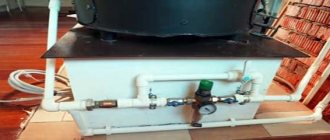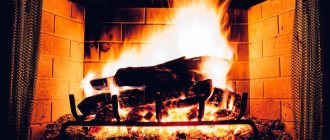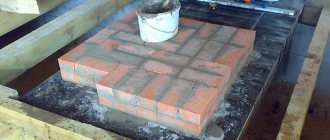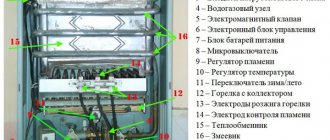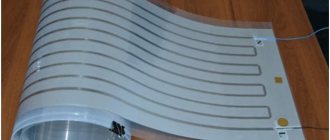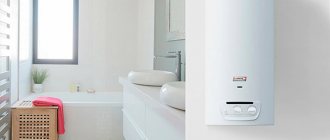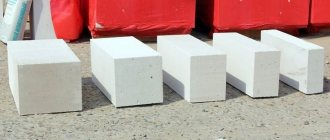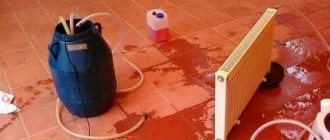When building a house, I had a question - gas (economical and convenient) or solid fuel (no options if there are no communications). But to my happiness, even before the interior finishing began, a gas pipe was laid along our street.
Questions about heating disappeared by themselves. However, in order to have an ace up my sleeve, I still left the shaft for a solid fuel boiler.
When choosing, installing and configuring the boiler, I had to study a bunch of nuances that in the future will save me money on heating my house. I would like to talk about them.
This is a story from our regular subscriber from Belarus, Yuri Sergeevich.
Boiler efficiency at different temperatures
· 40°C
. This mode is considered the most unfavorable in terms of gas consumption and comfort. Operating the boiler at minimum power is characterized by a decrease in efficiency. If you have a modern low-volume system, then the energy reserve in it will be minimal. If the boiler suddenly stops, the heating circuit will quickly cool down. At 40 °C the firebox will be “flooded” with condensate.
· 50°C.
The efficiency of the boiler in this mode increases and condensation formation decreases. 50 °C is set when the outside temperature is around 0 °C.
· 60°C.
This temperature regime can be considered the most economical in terms of gas consumption, comfortable for the boiler and heating system. The coolant warms up above the dew point, and condensation does not form on the heat exchanger.
· 70 °C and above.
This mode is considered the most economical. But from the point of view of comfort it cannot be considered optimal. At this temperature, the air in the rooms often overheats and takes a long time to cool down to normal levels, even after the burner is turned off. If the heating system is assembled on polypropylene pipes, high temperatures will shorten their service life. Also, some boiler owners note the presence of an unpleasant smell of “burnt dust”.
Heating system without special adjustments
Such a system, of course, is a relic of the past, but it still occurs, and quite often. That is, we have a boiler on which you can one way or another set the temperature of the water that the boiler maintains. Why is this adjustment alone often not enough?
Some features of temperature control on a gas boiler There are types of automatic gas boilers when we can increase its temperature at any time, but cannot reduce it. To reduce the temperature, we must first cool the boiler completely, and only then adjust it to a lower temperature. This is different not so much from old and wretched boilers as from boilers with non-volatile automation.
Scenario #1
Since our house is most often two-story, we do not need the same temperature on the second floor as on the first. The second floor is heated at the expense of the first, and if the radiators of the second floor heat up in the same way as the radiators of the first, and most often more strongly, then it is always a little hot on the second floor, and a little cold on the first floor. Women (especially thin ones) love warmth and everything suits them on the second floor. But in the kitchen on the first floor they are cold, which makes them ask you, as the owner of the house, to go down to the boiler and “turn on” the gas. You go and give in. After this, it becomes unbearably hot on the second floor, and more or less normal on the first floor. The wife is happy. Then she needs to go to the second floor - it’s scorching hot there. And then the wife, without hesitation, opens a window or even a window. It's hot! The heat flies away and you (the whole family) one way or another overpay for gas.
Moreover, even if the window is not opened, more heat is always consumed in an overheated room than in an underheated one. The more heat, the more it is consumed! So you don’t have to open the window or window. Excessive gas consumption is guaranteed without this.
Scenario #2
Our house is a mansion, that is, a free-standing cube or parallelepiped. On one side of the house there is usually south, on the other north. If the sun comes out in winter, it shines through the southern windows, and no matter how low and cold it is, the room heats up. It gets hot in there. We again end up with excessive heat consumption, because we have an excess of it.
Installation features
The user needs to be aware of the main requirements for installing the device:
- It is prohibited to place the device in a living room.
- In the utility room the boiler is placed in any convenient place. In the kitchen, the device should not be mounted above the dining table or above the stove.
- The distance specified in the instructions is maintained between the wall, surrounding objects and the device.
- The body and chimney become very hot during operation. If the device is placed near a heat-sensitive surface, this area must be insulated.
- Before entering the boiler, a shut-off valve must be installed on the gas pipeline. This device is not included in the package. If the water quality is poor, it is recommended to install a filter.
Upon completion of work, it is necessary to check the tightness of all connections. After this, they begin to check the equipment.
What is clocking of a gas boiler?
The clocking of a gas boiler is the frequency of switching on to heat the coolant. If external control devices are not connected to the equipment, then the interval between turning on the gas boiler can be no more than 10 minutes. The default interval is 3 minutes.
It is not recommended to turn on the equipment frequently. The most economical consumption will be with continuous operation of the gas boiler. If the equipment operates continuously for a long time, it means that a mode has been set in which heat losses in the house are compensated while maintaining a suitable temperature of the coolant.
Residents of small apartments often face the problem of high gas consumption. This is due to the fact that the equipment was designed for heating and water heating, and therefore has high power.
Different models of Baxi gas boilers differ in configuration parameter numbers, so you need to study the instructions before setting up the equipment.
Errors and malfunctions
If this is the first time you have seen a fault code on the screen, try to reset it by rebooting the boiler. If after turning on the code does not disappear, then read its decoding.
| Error code | Which indicator is on? | What does it mean | How to fix the problem |
| Error A01 | Kart. 1. | Problems with ignition. |
|
| A02 | Kart. 2. | The thermostat blocked the operation of the boiler. | Check the thermostat for functionality. |
| A03 | The combustion products removal sensor has tripped. | Check:
| |
| A04 | Kart. 3. | The thermostat has tripped. | Repair and replace the control module. |
| A05 | The NTC hot water supply (DHW) temperature sensor is faulty. | Inspect the contacts and sensor connections. Install the correct part. | |
| A06 | Kart. 2. | The NTC heating thermistor has failed. | |
| A07 | Kart. 2. | The relay did not open. | Perform diagnostics on the electronic module. |
| A 11 | Kart. 2. | Flame simulation. | Contact the service center. |
| ADJ | Kart. 2. | Power adjustment required (max. – min.). | |
| A24 | Problems with the fan. | The fan changes speed too quickly. Conduct diagnostics of the operation of the node, its connections and contacts. | |
| E33 | The phase and neutral connections are broken. | Reconnect the device. | |
| E34 | Frequently pressing the Reset key. | If the problem persists after 40 minutes, install a new slave board. | |
| E35 | Problems with the pressure switch. | Check the water flow in the circuits in accordance with the instructions. Replace the relay with a working element. | |
| E37 | False flame detection. | Reconnect the smoke sensor connections. Install a new sensor. | |
| E38 | The combustion products sensor is short-circuited. | Make a replacement. | |
| E39 | The tap sensor contacts are open. | Replace the wiring, tighten the contacts. | |
| E40 | Voltage fluctuations in the network. The frequency is not normal. | Install a voltage stabilizer. | |
| E42 | Short circuit of the sensor on the supply line. | Perform diagnostics of connectors, parts, and replacement of the faulty element. | |
| E43 | Sensor contacts are open. | ||
| E44 | Short circuit of the sensor on the return line. | ||
| E45 | Sensor open. | ||
| E46 | The supply thermistor indicates overtemperature. E47 for return thermistor. | Check that the fluid flow is correct. Normal values are 2 m³ per hour. | |
| E48 | High fan speed. The temperature of the exhaust gases has been exceeded. | Check water flow. Clean the heat exchanger from scale. | |
| 88° flashes. | Ignition standby mode. | ||
| Kart. 2 flashes. | The smoke exhaust pressure switch has tripped. | Inspect the chimney and clear any blockages. | |
| Card 3 blinks. | The hydraulic pressure switch has tripped. | Perform element diagnostics. | |
| P | Preheating of hot water supply. | ||
| P flashes. | A preheat request has been received. | ||
| Kart. 4. | Outdoor thermostat. | ||
| Kart. 5. | Turning on DHW. | ||
| Kart. 6. | Start heating. | ||
| Kart. 7. | Starting the “Anti-freeze” mode. | ||
| Kart. 8. | Flame in the burner. |
Other faults
Not all problems are indicated by an error code. If you notice any deviations in the operation of your Beretta gas boiler, our recommendations will help.
Smell of gas in the room
. Close the shut-off valves, ventilate the room, contact the gas service.
Smell of smoke, carbon monoxide
. Clean the chimney of soot and debris. Check that there are no foreign objects from the street above the shaft opening.
Burner ignites late
. Inspect the gas valve. Clean the burner and nozzles from dust. Adjustment of flame settings (modulation).
The boiler is working fine, but the radiators are cold
. Bleed excess air from the system using Mayevsky taps. Check the operation of the pump, set a different speed. Inspect the expansion tank for serviceability. Replace if faulty.
Maximum and minimum temperature of a gas boiler: which is better?
It is worth mentioning that for the calculation we took an ordinary wooden house with two rooms with a total area of 40 m². The quality of insulation is average, the boiler operates with a capacity of 24 kW. It is suggested that rooms should be heated to 21 degrees Celsius.
40 degrees
The most economically ineffective mode. Firstly, the boiler will underheat the rooms by about a degree to one and a half degrees. Because of this, the pump and burner will work constantly, which will lead not only to excessive gas consumption, but also to increased power consumption. Measurements show that electricity may be needed about 3 times more than at 70 degrees! Therefore, if there are problems with the power supply or the boiler is powered by a generator, you should refrain from this mode.
In this mode, the batteries begin to cool down literally after a few hours. It is also worth noting that with high wear and tear of the heating system, there is a high probability of condensation forming, which harms the boiler.
50 degrees
Typically, with such settings, the boiler shows the lowest gas consumption, but in this case the circulation pump works almost without stopping. Due to the high price of electricity, this mode is more expensive than the next.
The batteries take much longer to cool down, the boiler completely warms the room to the required temperatures.
60 degrees
Optimal settings for most boilers. At this coolant temperature, more gas is required than at 50 degrees, but the pump runs less often. The room is completely heated, the batteries take a long time to cool down, and the total costs are lower than other modes.
70 degrees
Even less electricity is required than at 60 degrees, but much more gas is needed. Although at first glance it seems that such settings are more profitable, the danger lies elsewhere. In this mode of operation, the batteries will begin to heat up, even when the boiler is turned off. Thus, temperature fluctuations in the room are possible, which will negatively affect not only comfort, but also the condition of the entire heating system, in particular the pipes.
80 degrees and above
It is not recommended to set such settings. Firstly, such settings are needed in severe frosts if you live in the northern regions of the country. Secondly, due to exposure to high temperatures, pipes quickly become unusable, and an unpleasant odor may appear.
Malfunctions and their elimination
According to consumer reviews, Beretta boilers have virtually no malfunctions. In case of breakdowns, the manufacturer has provided independent diagnostics of the equipment. This function includes control sensors that detect problems in the system, signaling this to the control module. As a result, the boiler stops working, and the LCD screen shows an error code. To resolve the error, you need to fix the problem.
Error “A 01” indicates that there are problems with ignition.
In this case it is necessary:
- make sure that fuel is supplied by opening the shut-off valves;
- check the serviceability of the fuel tap;
- examine the terminals;
- diagnose the ignition electrode - in some cases, the electrodes may become clogged, so they need to be cleaned with sandpaper;
- change the control unit.
Error “A 02” indicates that the thermostat is broken. To fix the problem, you need to check the functioning of the thermostat.
Error “A 03” indicates that exhaust gases are not discharged through the chimney.
To fix this problem you need to:
- Check the draft by holding a lit match to the window. If the flame does not deflect, there is no draft.
- Clear the chimney of leaves or ice.
- Check the ventilation and clean the fan blades from deposited soot and dust.
Error “A 04” means that there is a signal from the thermostat. To fix the problem, it is necessary to repair and replace spare parts of the control unit.
Error “A 05” indicates a breakdown of the hot water temperature sensor. To fix the problem, you need to check the contacts and, if necessary, install a new part.
Error “E 40” indicates that the sensor contacts have opened. To correct the error, you need to change the wiring and tighten the contacts.
Error “E 42” indicates a short circuit of the sensor on the incoming line. To fix the problem, you need to diagnose the connectors and replace the faulty part.
Error “E 46” - the bell flashes, signaling an increase in coolant temperature. To eliminate the error, you need to check the consumption of the thermal agent. The optimum is 2 cubic meters per hour.
Not all faults that occur are indicated by an error code.
If other deviations appear in the system, the following recommendations will help:
- If the heating equipment is functioning normally, but heating does not occur, then the problem may be that the pressure in the system has risen. To do this, you need to remove the air using a Mayevsky valve. The pump may also not start, so you need to check its serviceability and switch to a different speed.
- Smell of carbon monoxide and smoke. The problem can be solved by cleaning the chimney from leaves and soot.
List of sources
- expert-dacha.pro
- vmeste-masterim.ru
- stroy-podskazka.ru
- sovet-ingenera.com
- mr-build.ru
- boilervdom.ru
- Master-rzn62.ru
Coolant temperature
Gas saving is also associated with proper adjustment of the coolant. The standard configuration of a gas boiler does not include an outdoor temperature sensor, so you must independently adjust the temperature depending on the weather. For example, decrease or add. This method is not suitable for everyone, since it is necessary to constantly monitor the temperature. Baxi gas boilers have the ability to connect additional functions. Therefore, you can purchase a separate outdoor temperature sensor and connect it. This way the temperature will be adjusted automatically according to weather changes. In addition, you can use weather-sensitive automation. In the equipment settings, you must select a climate curve. In accordance with the parameters, the gas boiler will consume less gas.
The most economical heating boilers
How to reduce gas consumption in the heating system? First of all, you need to choose a device that is suitable for your home. Why is that? Because only taking into account the area of the room, wall material, number of windows and other factors can one calculate the required power and performance of the boiler. Only then will the equipment effectively release heat without wasting unnecessary energy.
If you want to save on gas consumption, then connect only to the public mains. Using cylinders is very expensive. What criteria influence savings:
- Design features;
- Efficiency factor (efficiency);
- Power of equipment;
- Fuel quality;
- Optimal mode.
Let's go through each point in more detail.
Equipment design
Heating boilers come with one and two circuits. A single-circuit device is designed only for heating the room, and for hot water supply (DHW) you will have to additionally connect a boiler. But dual-circuit models already include everything necessary for heating the house and for hot water supply.
To calculate savings, pay attention to the type of combustion chamber. The open chamber takes air from the room to maintain combustion and remove gases. The closed one forcibly brings in air from the street. Combustion products are removed by a fan. This principle promotes complete combustion of fuel, as well as minimal CO2 emissions.
Closed-type devices are connected to a coaxial chimney. Its tube-in-pipe design traps more heat. Therefore, the air from the street is heated, which increases combustion efficiency.
Effect of efficiency
Today the market offers the buyer convection and condensation boilers. Which one is more economical? It is considered to be condensation because it uses the energy of condensate. When taking into account additional energy, a conventional unit has an efficiency of 92-94%, and a condensing unit has an efficiency of 100-102%.
Standard operation involves burning fuel and venting gases to the outside that are at a high temperature. Combustion products contain impurities and moisture. Passing through the heat exchanger, the gases reach 60°. This causes sediment to form and accumulate in the tank. The process releases energy, which is used by the condensing device. It is believed that this can save up to 20% of fuel. But even here there are pitfalls. Such units are installed in low-temperature systems with heated floors.
There are also a number of other nuances that we described in the article “What is a gas condensing boiler”.
What affects the efficiency of a convection boiler:
- Physical underburning. When air burns instead of gas. The quality of the fuel affects;
- Chemical underburning. Depends on the amount of carbon monoxide during the combustion process;
- Poor insulation and wall insulation.
How to set up optimal performance:
- Clean the system at least once a year. Remove scale from the heat exchanger, soot from the burner and tubes;
- Place a damper on the pipe to restrict air flow;
- Clean soot from combustion chamber parts, otherwise gas consumption will increase.
How to save on gas heating
The desire to spend as little as possible on heating is quite natural.
When using gas, there are several ways to save fuel:
- Installation of a gas flow meter. The problem is very relevant, since in the absence of a meter, the resource supplying organization will charge the consumer not for the specific volume of fuel consumed, but according to regional standards. The difference can be up to 2-3 times.
- Reduced heat loss. For example, a private house can lose up to 25% of heat through the roof, up to 25% through windows, up to 35% through walls, and up to 3% through a door.
- Maximum use of automation equipment. Automation will monitor the necessary parameters better than a human.
- Increasing the efficiency of equipment operation. For example, replacing an old-style burner with a more modern version can save up to 5% of gas.
- Application of new means of ventilation. These include recovery systems - this is when the exhaust pipe of a gas boiler through the wall of the house passes inside the supply ventilation pipe. Outside the house, the exhaust pipe raises the exhaust gases much higher, and the cold air from the street enters the house already slightly warmed up. The use of a recuperator allows you to save 5-10% of the volume of gas consumed.
Hot water priority
In the hot water priority mode, we observe a clear sequence of actions and cyclic switching on for heating. If you want to turn on one of the hot water taps, the boiler will forget about heating and begin to heat the water. This is called hot water priority.
The heating works around the clock, the boiler knows when to turn on and off, maintaining the required temperature in the house. The need for hot water is much less frequent than the need to heat a house. When you turn on the water, the house is “already warm,” but the water is “still hot.” Therefore, priority for heating hot water is higher than for heating.
In most modern gas boilers, the water temperature can be adjusted separately in the range from 35 ºC to 55 ºC. The procedure is similar to the heating procedure. Set the appropriate temperature and use hot water.
Frost protection
The most important mode is frost protection. The mode is active when the boiler is switched off or winter mode is switched off. Why is it needed:
- the burner continues to work;
- the boiler was in working order;
- works when the heating is turned off.
Not every boiler has a protection mode. When the boiler turns on when water is supplied, the outlet water temperature is checked. Each boiler has a separate threshold, most have 5 degrees. If the temperature is 5 degrees, the boiler brings it to 15, then turns off.
How to optimize the operation of the boiler and heating system?
There are two ways to optimize individual heating:
· Install a room thermostat
. This method is suitable for houses with short heating systems, where there is no temperature difference between the rooms. The control of the gas burner is transferred to the room thermostat, which sets a comfortable temperature. At the same time, the thermostat built into the boiler remains in operation. It protects the heat exchanger from overheating.
· Equip radiators with thermostatic heads
. This method is suitable for large houses with an extensive heating system. It allows you to adjust the temperature in each room individually.
Both methods “work” at a temperature in the boiler of 60 – 65 °C.
You can order a boiler with a gas burner and get advice on its operation on the website.
Automatic space heating system - trust, but verify
Modern gas boilers are equipped with a function for automatically selecting the operating mode depending on the presence of people in the rooms. This allows you to maintain the temperature at a certain level even during a long absence of the owners. This setting can only be used if the system is periodically monitored by neighbors or relatives. This is due to the fact that in the event of unforeseen problems, for example, an emergency shutdown, the entire heating system of the building will fail.
As practice shows, there can be quite a few reasons for turning off the boiler:
- reduction of network voltage;
- power outage;
- reduction in the cross-section of the chimney due to ice formed there;
- reducing gas pressure;
- burner extinction as a result of strong wind entering the combustion chamber.
Beretta CIAO 24 CAI
This device is designed for wall mounting; it has two heating circuits - heating and hot water supply circuits, while the combustion chamber is of an open type. What are the main advantages of this equipment? We will indicate the following list.
- There is an information display.
- The power can be adjusted smoothly.
- Automatic adjustment of the coolant temperature.
- The circulation pump has three speeds and is protected from failures.
- Possibility to reconfigure equipment for liquefied gas.
- The thickness of the heat exchanger wall has been increased on the latest models.
- The installation has ionization type flame control.
- The water pressure is controlled by a hydraulic pressure switch.
- There is also smoke control.
In order to understand how this unit works, we provide brief instructions for this wall-mounted Beretta double-circuit gas boiler.
- Operating modes are displayed with special icons on the unit’s display panel.
- To activate the operation of the equipment, you need to turn on the power supply, open the gas tap, adjust the room temperature regulator and set the “winter” or “summer” mode according to the situation.
- Switching off is done using a special “shutdown” button.
The described device has some relative disadvantages. We list them below:
- since the combustion chamber is open, it is necessary to have an equipped chimney in the room;
- Sensors may become clogged.
We have dealt with this model, and now we will study another model.
Wall mounted Beretta CITY 24 CSI
This equipment also provides for wall mounting. There are also two circuits here, but the combustion chamber is closed, so the smoke exhaust is forced. The power is 24 kW, and the area of the heated room can reach 240 m2.
The main best qualities of the equipment are listed below.
- copper primary heat exchanger;
- protection against freezing and overheating;
- automatic diagnosis of equipment errors;
- the heating temperature of the coolant is adjusted automatically;
- power is adjusted smoothly;
- frost protection and pump blocking.
As you can see, this model has functions similar to those of the previous model. Now we will briefly present the operating instructions for the described Beretta gas boiler.
- The display panel also uses icons; conventional images are deciphered in the technical data sheet.
- It is possible to connect a remote control.
- Installation rules are described in detail on the pages of the technical data sheet.
- The passport shows a connection diagram to a horizontal coaxial chimney, which must be purchased separately.
- To start the equipment, you need to fill the system with water, turn on the power, open the gas tap, and set the regulator to room temperature. Turn on the “winter” or “summer” mode.
- The equipment is turned off using the power button.
Error codes are also indicated. That is, these are encrypted faults that a Beretta double-circuit gas boiler can show on the display panel. However, we will now talk about them in more detail.
Comparisons and problems
To summarize, we made a summary table for the two models described. The bottom line is this: the boilers are approximately similar, and both are very attractive to the consumer. Here is the table:
The table below includes information about faults that consumers have experienced with one or another Beretta gas boiler. We will describe what you can try to do in case of certain problems with your own hands.
- Among the malfunctions of the Beretta gas boiler, there may be breakdowns in which the unit does not turn on. Most likely, the reason is either a lack of water or a lack of power. The worst case scenario is a failure of the system board. Only the customer service will help here.
- Blockage due to excess chimney pressure is possible, but this can occur due to strong street wind.
- The automation should detect sensor problems itself.
- The equipment may also not turn on due to condensation in the chimney; the latter must be checked, among other things, if the unit does not turn on.
- There are cases of equipment failure due to frost at the chimney outlet. The sensor is triggered, and as a result, the equipment does not work.
Here are the main problems that you may encounter when operating the described boiler equipment.
Have you been facing problems with central heating or hot water supply for a long time? These issues can be solved by installing a gas boiler.
Each season has its own regime
Modern boilers are very easy to adjust a variety of parameters, including the intensity of fuel combustion. This function was introduced for a reason, but to prevent excessive fuel consumption due to clocking. It is recommended to choose your own regime for each season:
- Winter - maximum or average power.
- Spring, autumn - minimum power, in March and November - average.
- Summer - the boiler is not used, or - minimum flame.
However, these settings are relevant if the boiler matches the size of the heated room. Many people take equipment “with a reserve” of power, implying severe frosts, deterioration of the heat-saving properties of housing, or an increase in the area of the premises. In this case, it is recommended to immediately set the flame to minimum, especially if the boiler is wall-mounted.
Burner adjustments may stop working or operate incorrectly over time. If boiler repair is not possible, you can change the flame power using a valve on the gas pipe. This method is rarely used in practice, since valve wear can lead to leaks.
Common problems with the boiler during setup and how to fix them
The most common and widespread problem is the incorrect setting of the smooth operation of the gas valve. Hence the uneven temperature of the hot water and the explosion of gas in the combustion chamber during ignition.
All this causes a lot of inconvenience: it is impossible to wash properly due to the contrast in water temperature, and a thumping boiler causes acoustic discomfort.
The water pressure in a de-aerated system must also be kept at the level recommended by the manufacturer, since pressure that suddenly drops below normal can turn off the boiler.
Which, for example, in the event of a long absence, is fraught with big problems. Or, on the contrary, excessively high pressure will cause the relief valve to operate.
Constantly used maximum temperatures can also damage the heat exchanger.
It can either burn out or become clogged with lime deposits, like a kettle, because high temperatures form scale, especially in hard water. Yes, and underfloor heating tubes have a service life related to temperature.
At 70-80 degrees, tubes degrade 5 times faster than at 50-60. I myself read these numbers in the instructions for the heated floor.
A failed heat exchanger due to incorrect flame settings.
Only a boiler that is correctly configured according to all parameters and rules will be able to bring joy and warmth to your home, and not constant problems, frayed nerves and repairs.
Repairs, by the way, are quite expensive, since the entire components are replaced and the prices for them are quite steep.
True, if you don’t know anything about software settings, it’s better to entrust this to professionals. So don't skimp on settings, but save on gas and electricity. It's hard to disagree with this, isn't it?
Error A01 Beretta boiler
In beret boilers, error A01 (or A01 in Russian) indicates problems with the ignition system (lack of flame, faults in the control board). This may be due to the following reasons:
- 1. The flame detection electrode is dirty. You can clean the electrode from any deposits that have appeared on your own.
- 2. Lack of gas supply. There is a disruption in the supply in the main gas pipeline or the gas valve is simply closed (open).
- 3. Malfunction of the gas valve. Only a qualified specialist can adjust the operation of the valve.
- 4. The reliability of the connecting contacts on the ignition unit is compromised. Corrects itself. Disconnect, clean, connect.
- 5. Failure of the relay included in the control system for the operation of the ignition unit, gas valve, fan. This problem can only be resolved by a specialist. The reason may be either in the relay itself or in the electronic board.
Error A02 Beretta boiler
If the boiler display shows error A02 (A03), then in this case there is a problem with a violation of the temperature regime. Usually occurs in the event of a sharp drop in pressure in the coolant circulation system. The reasons may be the following:
- 1. Circulation pump malfunction. Pump operation may be impaired due to contamination. After several starts it can work normally. It is not recommended to disassemble it yourself. This should be done by a specialist. Only he will determine the cause of the malfunction and repair the pump or replace it.
- 2. Temperature sensor malfunction. This malfunction can only be eliminated by replacing the part.
- 3. Violation of the integrity of the electrical connections by the sensor. It is necessary to check the integrity of the wiring insulation and check the reliability of the contacts.
Error A03 Beretta boiler
The boiler display shows error A03, problems with removing combustion products. This may be due to:
- 1. Clogging of the combustion products exhaust channel. This situation rarely occurs; there are practically no gas combustion residues. But the cause may be the appearance of ice at the outlet of the pipeline system due to condensate freezing. Strong wind can also cause difficulty in removing combustion products, which results in the thermostat triggering, shutting down and blocking the boiler.
- 2. Lack of air supply, in case of forced smoke removal. The main problem is a broken fan. Will need replacement.
Error A04 Beretta boiler
On the display of the Beretta boiler, error a04 indicates a lack of optimal pressure in the heat exchange system. The error is similar to error a02. The only difference is that this code primarily indicates problems within the system of the boiler itself. The following error may appear on the display:
- 1. Clogged heat exchanger circuit inside the boiler. Long-term operation using hard water leads to the formation of scale on the internal surfaces of the heat exchanger. Adding chemicals to the heating circulation system helps remove it.
- 2. A leak has appeared. Sometimes a technician will be able to repair the heat exchanger on site (solder it). Otherwise you will have to make a replacement.
- 3. Violation of the tightness of the heating system circuit. Such problems can be eliminated yourself using tools and sealing materials.
- 4. Malfunction of the circulation pump. The pump needs to be replaced.
- 5. Poor contact of electrical wiring with pressure sensor. Removable by yourself (clean and connect).
- 6. Pressure sensor failure. Will need replacement.
The instructions attached to all models of BERETTA boilers indicate most of the errors of Beretta boilers with a description of possible problem situations that arise during operation. In addition, the operating parameters of the boilers are displayed on the display. For example, by comparing the error code of the Beret City boiler and the parameters of the operating functions, the technician is able to identify the problematic unit or component on the spot or eliminate the cause, which does not require complex repair work. Problems associated with the described errors should be resolved by qualified technicians. Only a technician who has practical experience in servicing gas boilers of various brands and models can carry out comprehensive diagnostics and determine the specific cause of errors on the display.
| Navien boiler repair | Baxi boiler errors |
| Installation of a heating system in a house | Gas boiler errors |
| Gas boilers with installation | Replacing heating radiators |
By contacting us, you agree to the terms of the “User Agreement” - Offer Agreement!
Remember - we are ALWAYS HERE!!!
User manual
I consider the following to be the most dangerous situations when using equipment:
- Gas pressure drop.
- No draft in the chimney pipe.
- Low voltage in the network.
- The igniter went out.
It is necessary to pay attention to such emergency cases, and do not forget about the constant maintenance of the device. Cleaning all elements will not only ensure productive operation, but will also extend the life of the product.
I always advise owners, in addition to setting up the gas boiler, to turn on the heating in the summer at least once every 2 months, then all components of the equipment will not fail at the time of startup in winter and will work as smoothly as possible.
Methods for setting the optimal mode
Many devices are programmed for the temperature of the coolant. When it reaches the required values, the unit turns off briefly. The user can set the temperature himself. The parameters also change depending on the weather. For example, the optimal operating mode of a gas boiler in winter is obtained at values of 70-80 C. In spring and autumn - at 55 - 70 C.
Modern models have temperature sensors, thermostats and automatic mode settings.
Thanks to the thermostat, you can set the desired climate in the room. And the coolant will heat up and cool down with a specific intensity. At the same time, the device reacts to temperature changes in the house and outside. This is the optimal operating mode for a floor-standing gas boiler. Although with the help of such devices it is possible to optimize the mounted model. At night, the settings can be reduced by 1-2 degrees.
Thanks to these devices, gas is consumed by 20% less.
If you want solid efficiency and savings from the boiler, purchase the right model. The following are some examples.
Model examples
- Baxi.
The optimal operating mode of this wall-mounted gas boiler is achieved as follows: in small apartments the indicators are set to F08 and F10. The modulation spectrum starts at 40% of the highest power. And the minimum possible operating mode is 9 kW.
Many models of this company are very economical and can operate at low gas pressure. Pressure limits: 9 – 17 mbar. Suitable voltage range: 165 – 240 V.
- Vaillant.
Many devices of this brand work optimally under the following conditions: power - 15 kW. The feed is set at 50-60. The device works for 35 minutes, rests for 20 minutes.
- Ferroli.
The best conditions: 13 kW for heating, 24 kW for water heating.
- Mercury.
Water pressure in the network is maximum 0.1 MPa. The highest temperature indicator at the outlet section is 90 C, the nominal value of the flue gases is at least 110 C. The vacuum behind the apparatus is a maximum of 40 Pa.
- Navien.
Basically, these are two-circuit units. Automation works here. The mode is customizable. The room heating parameter is set. There is a pump that can reduce parameters by 4-5 degrees.
- Ariston.
Automatic setting of modes also works. Often people choose models with the Comfort Plus mode.
- Buderus.
The following values are usually set on the feed: 40 - 82 C. The current parameter is usually reflected on the monitor. The most convenient summer mode is at 75 C.
Positioning the thermometer correctly
There are two types of thermostat:
- Built-in - measures the temperature of the coolant, does not respond to external conditions.
- Remote - measures the air temperature in the room, does not react to the temperature inside the boiler.
With the first type, everything is clear - nothing can be changed, the thermometer does not involve transfer. The remote type must be positioned correctly - otherwise, every ventilation or operation of household appliances will disrupt the heating operation throughout the house.
Experienced craftsmen advise placing the device in the part of the room that cools most slowly. As a rule, it is located at a considerable distance from the boiler, so heating is also extended over time. Reducing the temperature to the lower limit will mean cooling the entire room - the heating will begin to operate normally.
In order for the burner to perform long, uniform cycles, you should not install a thermometer:
- Near windows, doors, cracks in walls.
- Near household appliances.
- Close to the floor or ceiling.
- In the basements.
The pump does not work - what to do?
If a failure of the circulation pump is noticed, it is necessary to stop the system and call a technician.
There can be several reasons for failure, from power problems to mechanical problems. The first reason is determined by testing and checking the condition of the pump motor.
The second reason can be detected by checking the condition of the moving parts of the pump, the absence of difficulties in rotating or moving parts of the mechanism, breakage or wear of gears and other elements.
The decision to repair or replace the pump is made based on the results of an examination of the performance and condition of the unit’s parts. If the forecast for repair work is favorable, the pump is restored, otherwise a complete replacement is necessary.
What’s better: setting up the boiler yourself or calling a specialist?
Setting up a boiler is a difficult task, but quite feasible. In this matter, you need to understand and take into account many factors, the main one of which is safety. It is important to understand that this equipment runs on gas. When working with it, special care and caution will be required.
When you just need to configure the programmer, choosing the desired mode is not difficult. And if there is a need to get into the boiler structure and disassemble it, it is better to use the services of a specialist.
Burner flame
One of the indicators of proper burner operation is the color of the flame. Gas equipment is characterized by an even bluish flame without admixtures of other colors. The presence of yellow or red splashes indicates that the burner is not working well, which reduces the efficiency of the heating equipment.
First of all, this applies to injection burner devices, but sometimes it is also typical for fan burners. The flame may simply lack oxygen. Also, dust and other small debris can get in with the air, which will clog the device, reducing the efficiency of the boiler. All this directly affects the flame. If it hums, the burner is loud, or the fire has changed color, you need to adjust the correct operation of the device.
Installation and operation
The installation of Beretta gas equipment is entrusted to company representatives. Otherwise, the owner of the heater is deprived of the right to warranty service.
The operating rules require the mandatory installation of protection against voltage surges. All mounted and turbocharged modifications are energy-dependent. For them, it is necessary to install an uninterruptible power supply and grounding.
Requirements for the room in which gas equipment will be installed:
- There must be at least 0.5 m between the upper end of the smoke exhaust pipe and the ridge of the roof.
- The door opening width is from 0.8 m.
- Ventilation is a must.
- Between the gas appliance and the wall - at least 0.4 m.
